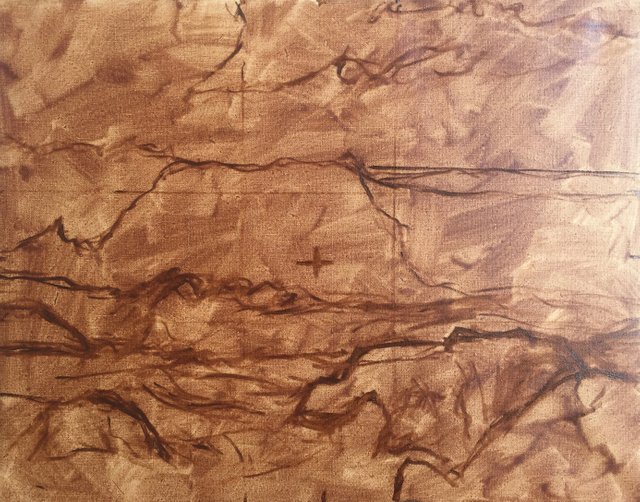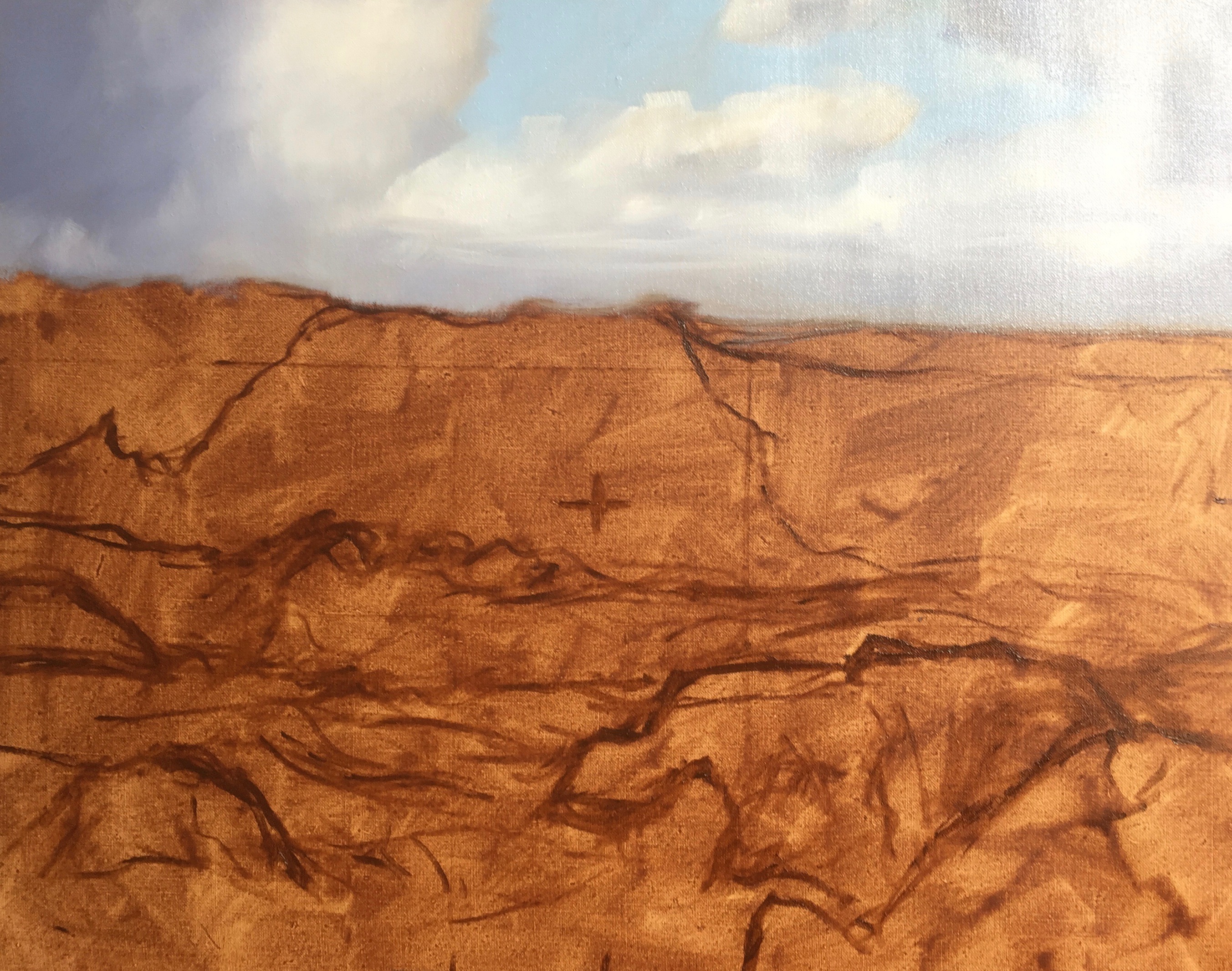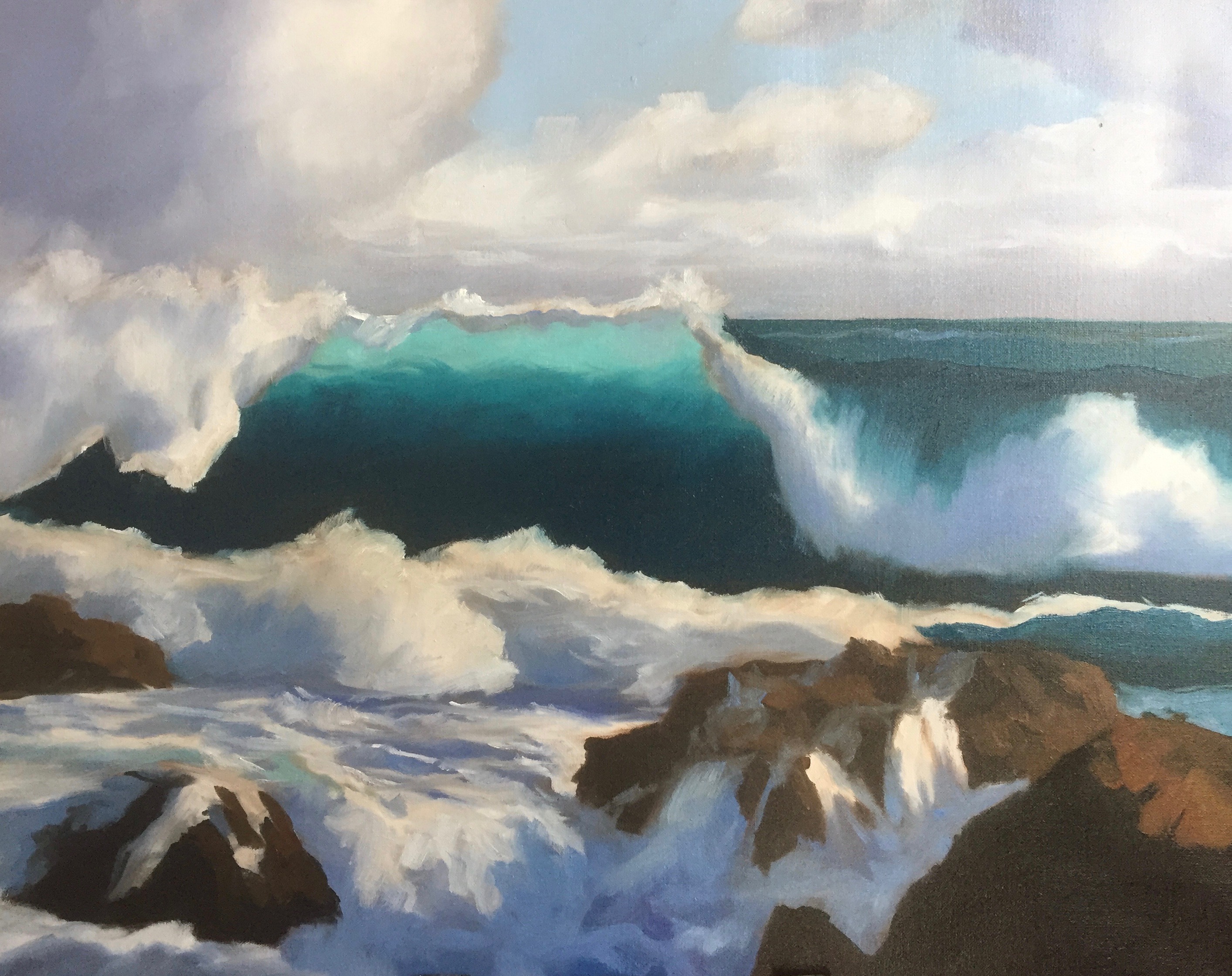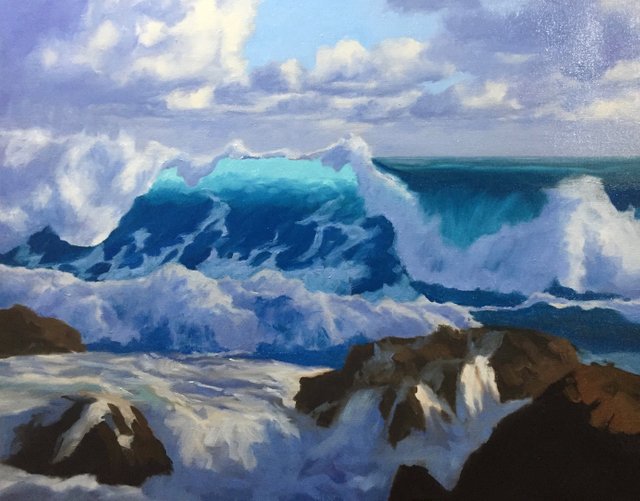How to Paint a Dramatic Seascape
Painting breaking waves is fun!!!! ...and you can create some awesome seascapes where a breaking wave is the main focus of the painting, add rocks, white water, spills, clouds and light angles and you can create some very engaging seascapes.
This seascape painting which I will show you how to paint was inspired by the coastline of Wellington, New Zealand, where the sea can be pretty rough when a southerly weather system is passing through...but at the same time provides excellent subject matter for seascape paintings.
So, lets get started....
STEP ONE:
Here is my canvas

The first thing you'll notice is that I am not painting on a white canvas. I preferred painting on a coloured background and in this case I have used burnt umber which gives vibrancy to the painting as I apply the paint layers.
I mark in my seascape drawing using a synthetic round brush and burnt umber. You may notice the cross in the middle of the painting and the faint lines in which I have incorporated the golden ratio. This helps me with my composition so I can reduce aberrations and other errors...but more about that in another blog post.
One of the most important things in seascape composition is the positioning of the horizon line. NEVER EVER place you horizon in the dead centre of the painting...NO NO NO, BAD!!!!! Either a high horizon or a low horizon. In this case I have gone for a high horizon as the focus of my painting is about the rough sea and the rocks...however you might use low horizon line if you want more emphasis of the sky or landforms.
STEP TWO:

I start with furthest distance and then work forward, in this case the sky. In order for the sky to recede I use desaturated colour my mixing ultramarine blue, burnt umber, quinacridone magenta and titanium white for the clouds. The blue sky is mixed with cobalt blue, cobalt teal and titanium white. In order to achieve colour harmony in the painting I will use these colours throughout.
I'm not concerned with detail when in the blocking stage of the painting. I use a chip brush and / or a larger bristle dagger brush so I can cover ground quicky.
STEP THREE:

Using a large bristle dagger brush I block in the main areas of the breaking wave and the white water. In this scene the direct light is coming from the right side of the painting. I increase the saturation of my colours to bring the wave and the white water forward.
STEP FOUR:

Finally I block in the shapes of the rocks, again I don't want to get bogged down in detail here. I've saved my darkest tones for the rocks in the foreground where some of colours are near black. This is mixed by combining ultramarine blue and burnt umber. Never use a pre mixed black as it won't coordinate well with other colours and can deaden the colours in the painting.
For the highlighted areas of my rocks I have used my go to earth colours which include, burnt umber, burnt sienna and yellow oxide.
STEP FIVE:

Once the block in is complete I allow the painting to dry and then make an assessment of the overall tonality and colour of the painting. As I begin the modelling phase of the painting I felt perhaps the breaking wave was a little too dark. I decided to increase the tone a little and the saturation of the blue. I have used a combination of ultramarine blue, cobalt blue and cobalt teal and in order to take some of the saturation out of the mix I have added a little burnt umber.
The translucent area of the wave is mixed with cobalt teal, pthalo green and titanium white. Go very sparingly with pthalo green as it's a strong colour and will quickly overpower your mixture if too much is used.
I transition the zones of colour in the wave by making purposeful marks and blending areas within the wave to give the illusion that the wave is curling as it's about to break.
STEP SIX:

At this stage I am modeling the paint in the white water and the breaking wave. I want to save my tonal best until last to make the painting pop and for that reason at this stage the highlights on the foam are not completely white. I have dropped the tone of the highlights by adding a little ultramarine blue, burnt umber and quinacridone magenta. This also coodinates well with the sky and the rest of the sea as I have used the same colours in the mix.
The shadow areas of the white water and foam are mixed using the same colours for the highlighted areas with the addition of cobalt blue and cobalt teal. Increasing the amount of quinacridone magenta can give the illusion of reflected light in the shadow areas of the white water.
STEP SEVEN:
As I am bringing the whole painting together I add the highlights of the foam and white water last. White is the lightest tone we can use so this must be saved until the very end in order to retain that tonal dynamic. Pure titanium white looks a little cold on its own I have added a glaze using a little nickel-azo yellow, yellow oxide and titanium white.
I refine the detail in the rocks in the foreground using more of my earth colours and whilst these are not high chroma colours, you can still attain a richness and achieve some tasty looking rock tones by using these colours in a purer form. In general you should save your most saturated colour for the forground as this will always come forward in a painting.
I have painted some reflected light in the rocks by combining cobalt teal and quinacridone magenta which cancel each other out to form a rich violet which can be lightened by adding a little titanium white.
NOTES ON COLOURS:
Lets talk more about the colours I have used in this painting. I have used Langridge Handmade Oils as I love the high pigment content and vibrancy that these paints produce as well as the physical handling. Whether you are using Langridge or another brand I would always recommend using an artist quality oil paint. It is best stick to one brand of paint as well as they will coordinate and mix better as well as speed up your painting process in the long run.
The three different blues to paint this seascape which include ultramarine blue, cobalt blue and cobalt teal are suitable for painting most seascapes. These colours on their own are powerful and if used straight from the tube will come forward in your painting.
In order to achieve a depth dynamic within your painting it will be necessary to knock down the blues a little to make them recede. This can be achieved by using some of these earth colours which will desaturate and in some cases add a warmth to the mix. These colours are also great for painting rocks.
If you have enjoyed this blog post and want to learn more about painting seascapes and landscapes, check out my website at: samuelearp.com
UPVOTED U AND FOLLOWED
PLZ DO THE SAME
Thank you, and I have followed you. How do you upvote posts, I am new to this platform?
great, thanks! I follow
Thanks :)